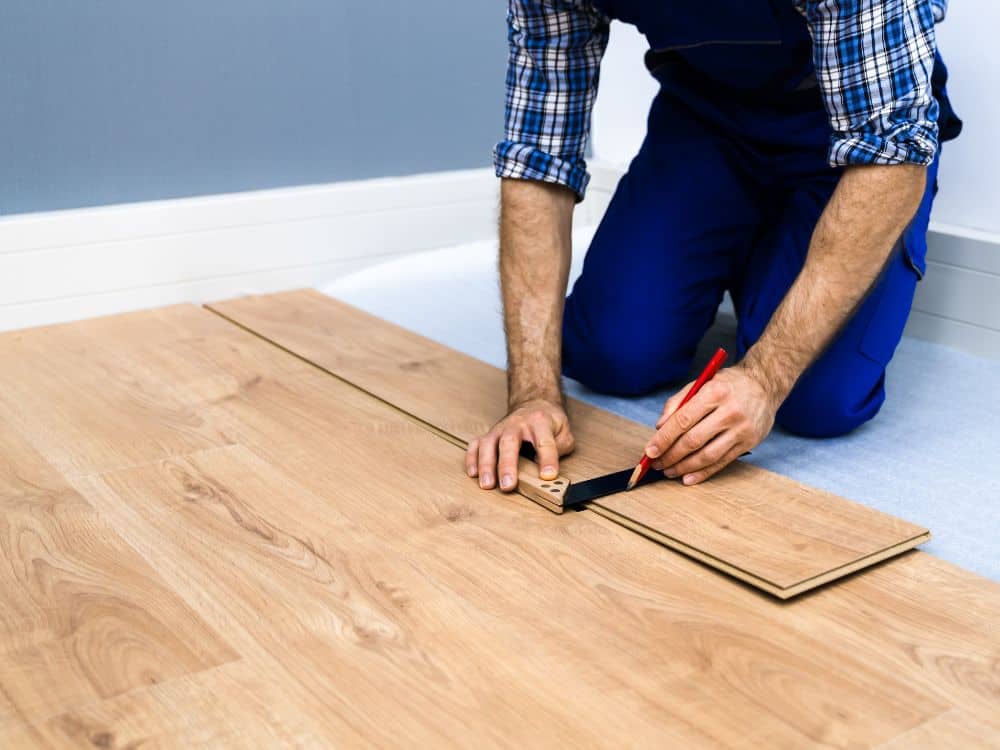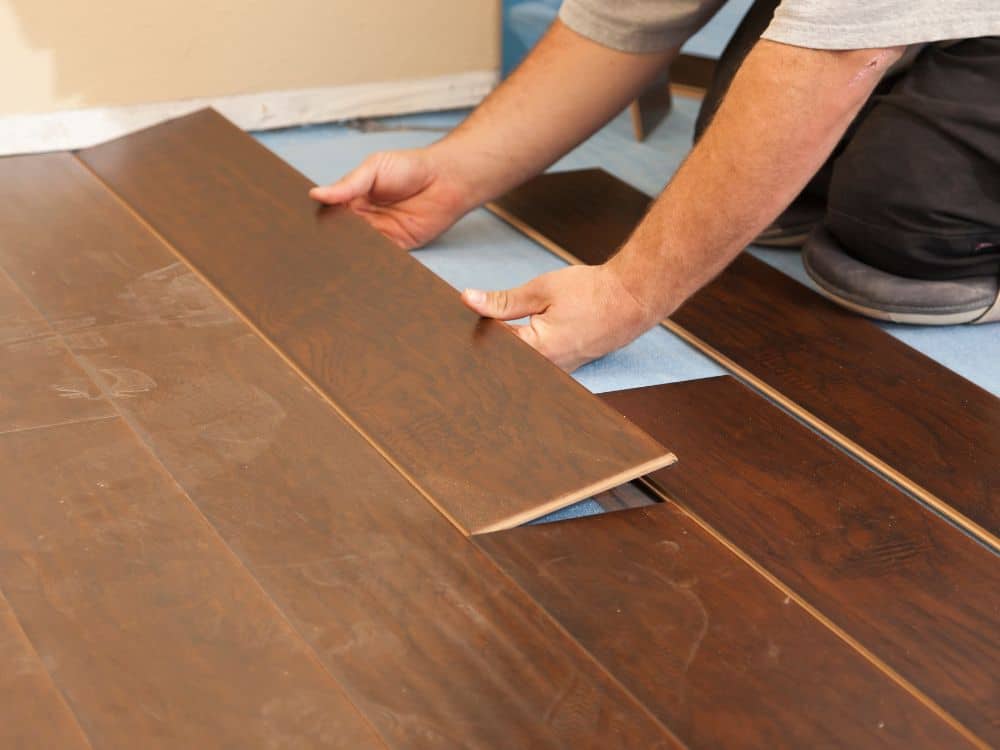As you’re looking for a new type of flooring for your home, you may have heard that laminate floor costs are lower than for any other type of flooring.
That is, indeed, true, however, it doesn’t mean that laminate can’t still cost you a substantial sum of money, especially depending on the types of laminate flooring, the square feet you need to cover, whether you need to call professionals to help with the floor installations, whether there is existing flooring that needs to be removed first, and so on.
So, with so many considerations to juggle between, what is the average cost to install laminate flooring after all?
Table of Contents
What is the average cost to install laminate flooring?
Just giving you a single number here could be misleading as there is a lot of variation in the prices of laminate flooring, depending on the type, labor costs, additional work that needs to be done, as well as where you live. Also, keep in mind that these prices generally fluctuate a lot over time so it also matters when exactly you’re reading this.
Still, at the time of writing this, we can say that laminate flooring generally costs somewhere between $2,70 and $11 per square foot. That is just the price of the laminate, however – labor costs will usually range between $4 and $8 too, bringing the total cost to anywhere between $7 and $20 per square foot.
So, for the average 150 sq. ft. room, this can mean anything from $1,000 to $3,000.
What goes into the price of laminate flooring?
To help you break this price range a bit, let’s go over the main components of the overall price one by one. After all, while you will always need to buy the laminate itself, you may be able to skip some of the other steps based on your situation.
1. The laminate itself
Most types of laminate are quite similar in principle – they all include a back layer with an underlayment that’s meant to balance the laminate and protect it from moisture, they all have more or less the same core layer, as well as the upper design and wear layers that determine the look of the laminate and protect it from wear and tear.
The quality of the laminate’s layers will be determined by its type and its manufacturer, however, and that quality difference plays a big role in the price estimates you can expect to see. The extent and type of the warranty will also play into the price but it’s always a good thing to have.
Overall, putting the design differences aside, you ought to consider the following three differentiating factors – surface types, installation types, and plank types.
Laminate surface types:
- Smooth laminate – doesn’t have any unnatural texture and can resemble anything from polished hardwood to ceramic or marble.
- Embossed laminate – has a textured, grainy look but isn’t actually textured and is still smooth.
- Distressed laminate – has an antique wood flooring look which is achieved via hand scraping during the laminate’s production.
- Gloss laminate – can be shiny or matte, depending on how it’s glossed over.
Laminate installation types:
- Click-lock laminate – this type is the easiest to install and it’s preferred by DIYers as the laminate planks just need to be clicked together. If installed properly, this laminate should be as durable as any other type but for proper installation, you may still want to call a professional for help.
- Glued laminate – this type requires that each plank be glued together. This is much more labor-intensive and will almost always require you to hire a contractor but the end result should be even more secure and durable.
- Pre-glued laminate – as the name suggests, this type of laminate comes with glue already applied to the planks’ grooves which allows you to just click them together as you would with click-lock laminate.
Laminate plank types:
- Traditional laminate plank – this is the laminate type you’ll see most often. The planks here are somewhere between 2.25 and 3 inches wide and mimic hardwood quite well.
- Wide laminate plank – these planks can be anywhere up to 5 or even 14 inches wide and don’t look like laminate to most people nearly as much as traditional planks.
- Thin laminate plank – contrary, think planks are less than 2.25 inches wide and give the room a much more modern and minimalistic look.
- Herringbone laminate plank – this type of laminate plank is usually as wide as traditional laminate but is L-shaped as they have a 90-degree corner in the middle. This gives the flooring a much more artistic look.
2. Labor costs
Hiring contractors is something that essentially doubles the overall cost of laminate flooring which is why a lot of people prefer traditional click-lock laminate planks.
Even with them, and especially with other types of laminate, hiring professional help is usually the smart way to go about it as it not only guarantees the quality of the installation but it effectively saves you so much time that it’s just worth it.
3. Surface treatments and previous flooring removal
Another big price-bump comes from the need to remove the previous flooring or repair the subfloor before installing the new flooring. Removing moisture is a big part of this as you don’t want any moisture trapped under the laminate – homeowners who’ve done this mistake can attest to its disastrous consequences.
Depending on what square footage you’re looking at, this can also ramp up the price by a lot but it’s still important to pay attention to even the smallest moisture stains on even the furthest corner subfloor tile.
Why should you choose laminate flooring over its alternatives?
Aside from the overall lower laminate flooring installation costs, there are many other benefits to this type of flooring too. After all, other types of flooring can have a tolerable cost estimate too but not all have the following:
1. Very affordable
Especially compared to hardwood flooring, marble, or some other types, laminate is just more affordable.
2. Easy to install even by novice DIY enthusiasts
If you have a free weekend and you absolutely don’t want to deal with contractors, you can save a bit of money if you just click-lock your laminate yourself. Do keep in mind that this is difficult, however, so you need to be sure you’re up for it.
3. It’s a very versatile option
Laminate planks can look like all types of wood – cherry, walnut, elm, maple, and many others. They can also be installed in many places where other types of flooring aren’t as simple to put down.
4. Surprisingly durable
While it’s not 100% water- and scratch-resistant, laminate is more durable than many people suspect. With good care, high-quality laminate flooring can easily last for decades while still looking great too.
5. Laminate is antibacterial and safer for people with allergies
As most types of laminate are smooth, they don’t gather as many allergens as other flooring types. So, if you have allergy sufferers at home, especially children, laminate is often the way to go.
6. It is one of the more eco-friendly options
Because of how it’s produced and because it’s recyclable and biodegradable, laminate is one of the most eco-friendly flooring options out there.
Extra notes for and drawbacks of laminate flooring to keep in mind
While laminate is one of the best types of flooring today by a lot of criteria, it’s not perfect and there are a few things to keep in mind before you settle on it.
1. Laminate isn’t as easy to fix as you might expect
A lot of people assume that if your laminate starts fading or is damaged, getting a replacement plank is easy and simple. And, while it is simpler than with some other types of flooring, it’s not as easy as you might think as it often requires the removal and reinstallation of most of the whole flooring.
2. It’s not water resistant
Water damage can easily get through the laminate seams and lead to moisture trapped under the flooring, to molding, and to a whole host of subsequent problems. This means that quick cleanup after even the smallest spill is a must – something that’s the case with some other flooring types but not all.
3. It’s not scratch-resistant either
If you have pets or kids, you may want to consider if the top layer of your new laminate flooring would handle the wear and tear coming its way. This isn’t always a problem – you can clip your pets’ nails and you can teach your kids to be more careful when they play.
However, it’s also worth considering whether you should cover the laminate with something or just go with a different type of flooring instead.
In conclusion
As you can see, while the overall cost to install laminate flooring is considerably lower than it is for most other flooring types, the end sum can still catch you off guard if you’ve failed to consider everything that goes into it.
Even for a single mid-sized room, the price for a full laminate flooring treatment can easily be in the low thousands, and for a larger room or for several rooms, you can be looking at several thousand dollars easily.
Being prepared monetarily is important but picking the right type of laminate and installing it properly is still the key consideration as that will determine not only the look of your home but the quality and comfort of the flooring as well.

